best grades
Your fellow student knows the best materials to research on and use. This guarantee you the best grades in your examination. Your fellow students use high quality materials, textbooks and notes on the assignment to ensure high quality.
- 529
- 0
- 32
Community
- Followers
- Following
3 Reviews received
559 items
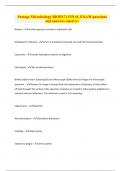
Portage Microbiology BIOD171 FINAL EXAM questions and answers rated A+
Nucleus - contains genomic content in eukaryotic cells Endoplasmic reticulum - series of membrane enclosed sacs and interconnected tubes Lysosomes - contain hydrolytic enzymes for digestion Chloroplast - Site of photosynthesis Briefly explain how a Scanning Electron Microscope (SEM) forms an image of a microscopic specimen. - Answer: An image is formed from the interactions of electrons as they reflect off (not through) the surface of the specimen. Samples are coated in either gold or pall...
- Exam (elaborations)
- • 8 pages •
Nucleus - contains genomic content in eukaryotic cells Endoplasmic reticulum - series of membrane enclosed sacs and interconnected tubes Lysosomes - contain hydrolytic enzymes for digestion Chloroplast - Site of photosynthesis Briefly explain how a Scanning Electron Microscope (SEM) forms an image of a microscopic specimen. - Answer: An image is formed from the interactions of electrons as they reflect off (not through) the surface of the specimen. Samples are coated in either gold or pall...
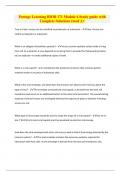
Portage Learning BIOD 171 Module 6 Study guide with Complete Solutions rated A+
True or False: viruses can be classified as prokaryotic or eukaryotic - False. Viruses are neither prokaryotic or eukaryotic What is an obligate intracellular parasite? - viruses cannot replicate unless inside a living host cell. As a parasite, a virus depends on its living host to provide the framework (proteins, etc) to replicate—to make additional copies of itself. What is a viral capsid? - a membrane-like protective structure that contains genetic material similar to nucleus of eukar...
- Exam (elaborations)
- • 12 pages •
True or False: viruses can be classified as prokaryotic or eukaryotic - False. Viruses are neither prokaryotic or eukaryotic What is an obligate intracellular parasite? - viruses cannot replicate unless inside a living host cell. As a parasite, a virus depends on its living host to provide the framework (proteins, etc) to replicate—to make additional copies of itself. What is a viral capsid? - a membrane-like protective structure that contains genetic material similar to nucleus of eukar...

Portage Learning BIOD 171 Module 3 Study guide with Complete Solutions rated A+
Does phase contrast microscopy require staining? - No Simple staining is used mostly for... - A quick observance Simple staining uses __________ dye. - Positively charged Acid fast stain is used for... - bacteria resistant to traditional staining; mostly for mycobacterium tuberculosis Resolution - distance between two objects at which the objects can still be seen as separate Contrast - difference in light absorbance between 2 areas Dark field microscopy light - reflects light off of spec...
- Exam (elaborations)
- • 4 pages •
Does phase contrast microscopy require staining? - No Simple staining is used mostly for... - A quick observance Simple staining uses __________ dye. - Positively charged Acid fast stain is used for... - bacteria resistant to traditional staining; mostly for mycobacterium tuberculosis Resolution - distance between two objects at which the objects can still be seen as separate Contrast - difference in light absorbance between 2 areas Dark field microscopy light - reflects light off of spec...
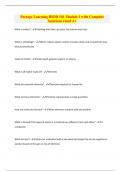
Portage Learning BIOD 101 Module 1 with Complete Solutions rated A+
What is matter? - Anything that takes up space, has volume and mass What is autophagy? - When cellular organic matter is broken down and recycled into new biomacromolecules States of matter - Solid, liquid, gaseous (vapor), or plasma What is all matter made of? - Elements What are essential elements? - Elements required for human life What are trace elements? - Elements required only in small quantities How are molecules formed? - When elements combine with one another What is formed if ...
- Exam (elaborations)
- • 14 pages •
What is matter? - Anything that takes up space, has volume and mass What is autophagy? - When cellular organic matter is broken down and recycled into new biomacromolecules States of matter - Solid, liquid, gaseous (vapor), or plasma What is all matter made of? - Elements What are essential elements? - Elements required for human life What are trace elements? - Elements required only in small quantities How are molecules formed? - When elements combine with one another What is formed if ...

Portage BIOD 171 Module 2 with Complete Solutions rated A+
What is cellular metabolism? - a controlled set of biochemical reactions that occur in living organisms in order to maintain life. What is the primary function of enzymes and how are they regulated? - Enzymes speed up chemical reactions. Most notably, the enzyme is not consumed during the reaction and can be used repeatedly by the cell. Enzymes can also be regulated by a cofactor such that in the absence of the proper cofactor, enzymes are inactive while in its presence enzymes are active. ...
- Exam (elaborations)
- • 4 pages •
What is cellular metabolism? - a controlled set of biochemical reactions that occur in living organisms in order to maintain life. What is the primary function of enzymes and how are they regulated? - Enzymes speed up chemical reactions. Most notably, the enzyme is not consumed during the reaction and can be used repeatedly by the cell. Enzymes can also be regulated by a cofactor such that in the absence of the proper cofactor, enzymes are inactive while in its presence enzymes are active. ...
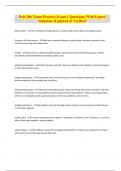
Pols 206 Tamu Practice Exam 1 Questions With Expert Solutions |Updated & Verified
Government - The institution through which a society makes and enforces its public policies Functions of Government - Maintain a national defense, provide public services, preserve order, socialize the young, and collect taxes Politics - the process of determining the leaders we select and the policies they pursue. politics procedures authoritative decisions about public issues. political participation - All the activities used by citizens to influence the selection of political leaders or...
- Package deal
- Exam (elaborations)
- • 9 pages •
Government - The institution through which a society makes and enforces its public policies Functions of Government - Maintain a national defense, provide public services, preserve order, socialize the young, and collect taxes Politics - the process of determining the leaders we select and the policies they pursue. politics procedures authoritative decisions about public issues. political participation - All the activities used by citizens to influence the selection of political leaders or...
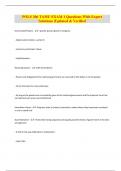
POLS 206 TAMU EXAM 1 Questions With Expert Solutions |Updated & Verified
Enumerated Powers - - Specific powers given to Congress - Stated under Article I, section 8 - necessary and proper clause - implied powers Reserved powers - -10th Amendment - Powers not delegated to the national government are reserved to the States or to the people - Forms the basis for many state laws - As long as the powers are not explicitly given to the national government and the Supreme Court has not deemed such a law unconstitutional Extradition clause - - Requires state to (ret...
- Package deal
- Exam (elaborations)
- • 16 pages •
Enumerated Powers - - Specific powers given to Congress - Stated under Article I, section 8 - necessary and proper clause - implied powers Reserved powers - -10th Amendment - Powers not delegated to the national government are reserved to the States or to the people - Forms the basis for many state laws - As long as the powers are not explicitly given to the national government and the Supreme Court has not deemed such a law unconstitutional Extradition clause - - Requires state to (ret...
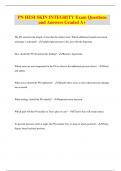
PN HESI SKIN INTEGRITY Exam Questions and Answers Graded A+
The PN measures the length of time that the redness lasts. Which additional wound assessment technique is indicated? - Apply light pressure to the area with the fingertips. How should the PN document this finding? - Reactive hyperemia. Which areas are most important for the PN to observe for additional pressure ulcers? - Heels and ankles What action should the PN implement? - Identify these areas as sites where pressure damage has occurred. What etiology should the PN identify? - Impaired...
- Exam (elaborations)
- • 4 pages •
The PN measures the length of time that the redness lasts. Which additional wound assessment technique is indicated? - Apply light pressure to the area with the fingertips. How should the PN document this finding? - Reactive hyperemia. Which areas are most important for the PN to observe for additional pressure ulcers? - Heels and ankles What action should the PN implement? - Identify these areas as sites where pressure damage has occurred. What etiology should the PN identify? - Impaired...

PN HESI Review Questions Med Surge with complete solutions | 100% pass
Three days after surgery, a male client suddenly grabs his right chest and becomes short of breath, pale, and diaphoretic. The practical nurse (PN) immediately assesses his vital signs and obtains 100/80 mm Hg blood pressure, 110 beats/min heart rate, and 36 breaths/min respiratory rate. What action is most important for the PN to take next? - Apply oxygen at 2 liters per nasal cannula. An elderly female client with dementia is transferred from a long-term care unit to an acute care unit. ...
- Exam (elaborations)
- • 12 pages •
Three days after surgery, a male client suddenly grabs his right chest and becomes short of breath, pale, and diaphoretic. The practical nurse (PN) immediately assesses his vital signs and obtains 100/80 mm Hg blood pressure, 110 beats/min heart rate, and 36 breaths/min respiratory rate. What action is most important for the PN to take next? - Apply oxygen at 2 liters per nasal cannula. An elderly female client with dementia is transferred from a long-term care unit to an acute care unit. ...
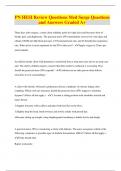
PN HESI Review Questions Med Surge Questions and Answers Graded A+
Three days after surgery, a male client suddenly grabs his right chest and becomes short of breath, pale, and diaphoretic. The practical nurse (PN) immediately assesses his vital signs and obtains 100/80 mm Hg blood pressure, 110 beats/min heart rate, and 36 breaths/min respiratory rate. What action is most important for the PN to take next? - Apply oxygen at 2 liters per nasal cannula. An elderly female client with dementia is transferred from a long-term care unit to an acute care unit. ...
- Exam (elaborations)
- • 15 pages •
Three days after surgery, a male client suddenly grabs his right chest and becomes short of breath, pale, and diaphoretic. The practical nurse (PN) immediately assesses his vital signs and obtains 100/80 mm Hg blood pressure, 110 beats/min heart rate, and 36 breaths/min respiratory rate. What action is most important for the PN to take next? - Apply oxygen at 2 liters per nasal cannula. An elderly female client with dementia is transferred from a long-term care unit to an acute care unit. ...

Exam B (MHA 708), MHA 708 QUIZ 1 | 208 Questions with 100% Correct Answers | Verified | Latest Updated 2024 | Already Passed
MHA 708 Study Quiz 1 with 100% Correct Answers | Verified | Latest Updated 2024 | Already Passed
AEM Certification Exam Questions And Answers Already Passed | Graded A+
best just like i wanted it